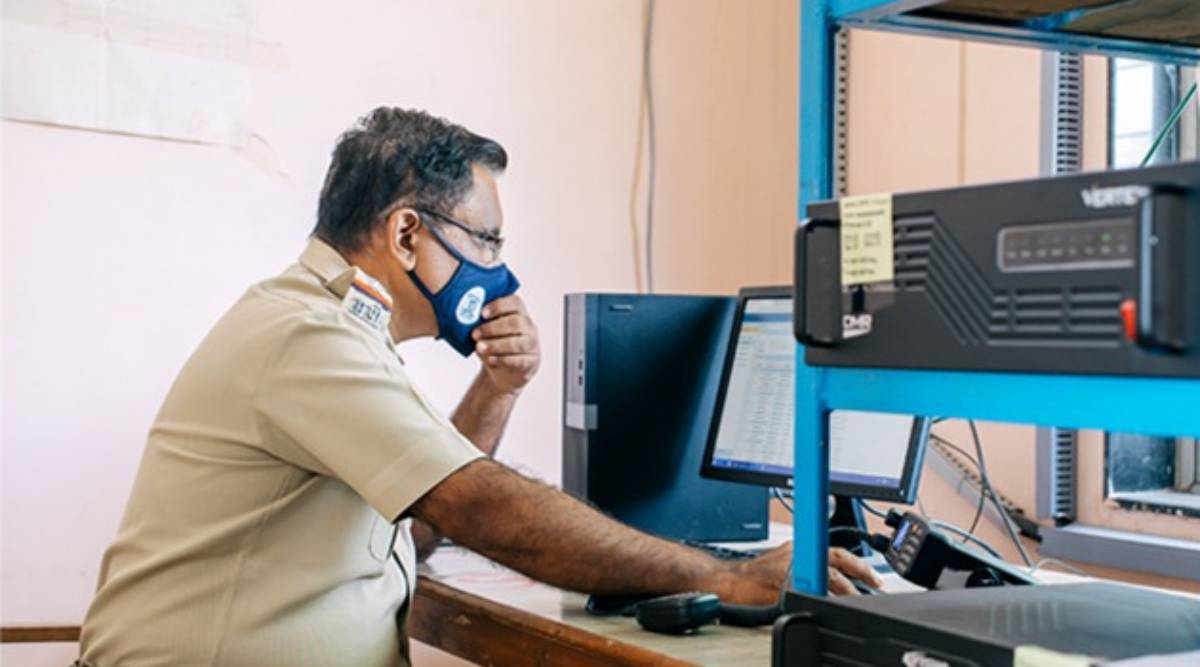 Every Sunday, an operator with Pune Police’s wireless wing sends a Morse Code message to the office of the Director General of Police, Maharashtra. (Photo: Twitter @Pune Police)
Every Sunday, an operator with Pune Police’s wireless wing sends a Morse Code message to the office of the Director General of Police, Maharashtra. (Photo: Twitter @Pune Police) IN THE era of satellite communication, which involves transmitting signals into space and back, and internet based systems transferring gigabytes of data in a flash, police have kept alive the age-old system of Morse Code – a primitive method of sending messages in the form of dots and dashes.
Every Sunday, an operator with Pune Police’s wireless wing sends a Morse Code message to the office of the Director General of Police, Maharashtra. While this is their way of paying tributes to one of the earliest modes of telecommunication, it is primarily a way of maintaining a robust stand-by mode of message delivery in case all other means of communication fail.
Pune City police have recently started a series of tweets featuring the communication systems used by the police and their evolution till date. On Sunday, Pune Police Commissioner Amitabh Gupta tweeted, “As an ode to the beginning of wireless communications, the Commissioner’s Office still uses Morse Code to transmit Messages every Sunday.”
Did you Know?
As an ode to #Technically the beginning of #Wireless #Communications – The
Commissioner's Office still uses #MorseCode to transmit Messages every Sunday!संदेश वहनाचा जुना मोड, तरीही स्ट्राँग आहे
'मोर्स कोड'!— CP Pune City (@CPPuneCity) July 18, 2021
Like all other police units’ functioning, Pune City police’s wireless and communications wing looks after three key functions.
First is operating the police communication that happens over PolNet — a satellite-based all India police communication network that is mainly used to transmit operations messages between police jurisdictions that include official communication and sensitive information. The PolNet is operated by the Directorate of Coordination for Police Wireless (DCPW) under the Union Home Ministry.
Second is managing the Police Exchange, a dedicated voice call network for the police units, which is not dependent on any telecom service provider. Third is operating the police wireless network used for the internal communication between police units, officers and branches of the Pune City jurisdiction. Maintaining the police control room (100 number) communication system is also one of the responsibilities of the wing.
आधुनिकीकरणाचे मोलाचे दालन,
"वायरलेस कम्युनिकेशन"#Technically the Wireless Communication Department made Modernisation achievable for the Pune & India's Police Force.Do watch -: #Equipment used by the #PunePolice since 1947!#BehindTheScenes #Gadgets #CallUsWhenYouNeedUs pic.twitter.com/BtpShONujJ
— CP Pune City (@CPPuneCity) July 19, 2021
While for these three communications satellite-based networks or very high frequency (VHF) channels, one Morse Code transmission module working on the robust high frequency (HF) bank is always kept on stand-by. Every Sunday, an operator uses the traditional Morse Code generator linked to an HF transmitter, which sends one test message to the DGP office. At present, Pune Police send the water-level data of Koyna dam.
Explaining why data of Koyna Dam levels are sent from Pune, an officer said, “Following the construction of major dams in Maharashtra, regional systems of dam vigilance were put in place, which involved sending of water level data to the state capital via the police wireless network. Levels from the Koyna basin were traditionally sent from Pune. Today, water-level data from river basins are sent through a computerised central network. We have continued sending the water level data as a test message. Almost all police units, especially in Maharashtra, maintain the Morse Code systems even to this date and it is one robust system that we can rely on in the case of a major calamity or communications failure.”
Officials said the job of sending the Morse Code message on Sunday is referred to as ‘Sunday Working’ in the unit’s own parlance and every time a different police wireless operator is asked to do the job to make sure that everyone gets to practice the Morse Code mechanism.
The wireless and communication wing of Pune city is led by an officer of assistant commissioner of police (ACP) rank and has one police inspector, four sub-inspectors, 28 assistant sub-inspectors and 50 constabulary staff. Coincidentally, the headquarters of Maharashtra Police’s wireless wing is also in Pune and looks after the procurement, frequency licensing, training and modernisation aspects of the police communication for the state.
The Pune CP said, “The police communication has a very rich history. Our attempt in this series of tweets is to introduce people to this key aspect of functioning of the police machinery. Some information videos and interesting facts on police communication are lined up for people in the coming days. In some upcoming series of tweets we will introduce our audience to more facets of policing.”
– Stay updated with the latest Pune news. Follow Express Pune on Twitter here and on Facebook here. You can also join our Express Pune Telegram channel here.
- The Indian Express website has been rated GREEN for its credibility and trustworthiness by Newsguard, a global service that rates news sources for their journalistic standards.

